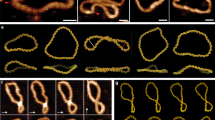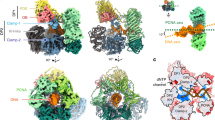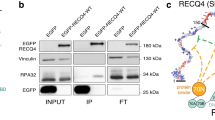Abstract
Pohl and Jovin1 have shown that poly (dG–dC) · poly (dG–dC) in solution undergoes a cooperative transition at 2.5 M NaCl at neutral pH. The two forms of the polymer are structurally different as indicated by a change in ethidium bromide intercalation and in circular dichroism (CD)1,2. Wang et al.3 and Davies and Zimmerman4 have suggested that the low salt form of the polymer might correspond to the B form of DNA (right-handed helix) and the high salt form to the Z form of DNA (left-handed helix). We describe here a salt-induced transition of supercoiled PM2 DNA from a form which passes through nitrocellulose filters to a form which is retained by these filters. The transition occurs between 2.5 and 3.5 M NaCl. The dependence of the apparent equilibrium constant on the salt concentration indicates a cooperative transition. Irradiation of DNA with UV light or alkylation with N-acetoxyacetylaminofluorene (AAAF) shifts the transition to lower salt concentrations. The transition can also be observed with linear DNA but requires a much higher salt concentration.
This is a preview of subscription content, access via your institution
Access options
Subscribe to this journal
Receive 51 print issues and online access
$199.00 per year
only $3.90 per issue
Buy this article
- Purchase on Springer Link
- Instant access to full article PDF
Prices may be subject to local taxes which are calculated during checkout
Similar content being viewed by others
References
Pohl, F. M. & Jovin, T. M. J. molec. Biol. 67, 375–396 (1972).
Pohl, F. M., Jovin, T. M., Baehr, W. & Holbrook, J. J. Proc. natn. Acad. Sci. U.S.A. 69, 3805–3809 (1972).
Wang, A. H. J. et al. Nature 282, 680–686 (1979).
Davies, D. R. & Zimmerman, S. Nature 283, 11–12 (1980).
Tunis, M. B. & Hearst, J. E. Biopolymers 6, 1218–1223 (1968).
Maestre, M. F. & Wang, J. C. Biopolymers 10, 1021–1030 (1971).
Mercado, C. M. & Tomasz, M. Biochemistry 16, 2040–2046 (1977).
Nelson, J. H., Grunberger, D., Cantor, C. R. & Weinstein, I. J. molec. Biol. 62, 331–346 (1971).
Fuchs, R. P. P., Lefevre, J. F., Pouyet, J. & Danne, M. P. Biochemistry 15, 3347–3351 (1976).
Marmur, J. & Doty, P. Nature 183, 1427–1429 (1959).
Depew, R. E. & Wang, J. C. Proc. natn. Acad. Sci. U.S.A. 72, 4275–4279 (1975).
Pulleyblank, P. E., Shure, M., Tang, D., Vinograd, J. & Vosberg, H. P. Proc. natn. Acad. Sci. U.S.A. 72, 4280–4284 (1975).
Waalwijk, C. & Flavell, R. A. Nucleic Acids Res. 5, 3231–3236 (1978).
Wang, J. C. J. molec. Biol. 87, 797–816 (1974).
Hays, J. B. & Boehmer, S. Proc. natn. Acad. Sci. U.S.A. 75, 4125–4129 (1978).
Cozzarelli, N. R. Science 207, 953–960 (1980).
Author information
Authors and Affiliations
Rights and permissions
About this article
Cite this article
Kuhnlein, U., Tsang, S. & Edwards, J. Cooperative structural transition of PM2 DNA at high ionic strength and its dependence on DNA damages. Nature 287, 363–364 (1980). https://doi.org/10.1038/287363a0
Received:
Accepted:
Published:
Issue Date:
DOI: https://doi.org/10.1038/287363a0
Comments
By submitting a comment you agree to abide by our Terms and Community Guidelines. If you find something abusive or that does not comply with our terms or guidelines please flag it as inappropriate.



